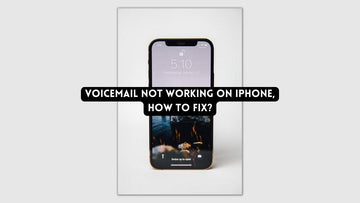How to Setup your AirTag Securely and Keep your Belongings Safe?
by Chelsea Bruhl on Sep 26, 2024

AirTag is a small tracking device developed by Apple, designed to help you locate and keep track of your belongings.
It can be attached to keys, bags, wallets, and other items to help you locate them if they are lost or misplaced.
Therefore, it is important to take some precautions to secure your AirTag and keep your belongings safe.
So, how to setup your AirTag securely? Firstly, make sure that you have the latest software updates installed on your device. Then, when pairing your AirTag, be sure to choose a custom name for it and enable Lost Mode. This will ensure that if your AirTag is separated from your device, it will send you a notification and can be tracked. Additionally, consider enabling Precision Finding and make sure to regularly check your Find My app to ensure that your AirTag is still securely connected.
In this article, we will discuss some of the steps you can take to protect your AirTag and personal data from falling into the wrong hands.
How to Setup your AirTag Securely?
Setting up AirTags is a simple process, but it is important to do it securely to ensure that your data and privacy are protected.
Here is a step-by-step guide on how to set up AirTags securely:
- Make sure your iPhone or iPad is updated to the latest version of iOS or iPadOS. AirTags require iOS 14.5 or later to function.
- Remove the plastic tab from your AirTag to activate it.

- Hold the AirTag near your iPhone or iPad, and you will see a prompt on your device's screen asking if you want to set up the AirTag. Tap "Connect."
- Follow the on-screen instructions to name your AirTag and assign it to a specific item, such as your keys, backpack, or wallet.
Once done you will be asked to enable certain features such as lost mode and sound notifications which can help you find out where your AirTag is at all times.
Enable Lost Mode
The first step you should take to secure your AirTag is to enable Lost Mode. This feature will lock your AirTag and prevent anyone from pairing it with their device.
When you enable Lost Mode, you can also add a phone number or message that will be displayed on the screen of the device that finds your AirTag.

This will make it easier for someone to contact you and return your lost item. To enable Lost Mode on your AirTag, follow these steps:
- Open the Find My app on your iPhone or iPad.
- Tap on the AirTag that you want to enable Lost Mode for.
- Tap on "Enable Lost Mode" and follow the instructions.
Enable and Use Precision Finding for your AirTags
Using Precision Finding with AirTags is a great way to get more accurate location information about your tagged items.
To use Precision Finding, you'll need to have an iPhone 11 or newer with iOS 14.5 or later installed.
- First, make sure that your AirTag is nearby and that Bluetooth and Location Services are turned on.
- Then, open the Find My app on your iPhone and select your AirTag.

- Next, tap on the "Play Sound" button to make your AirTag emit a sound.
- Once your AirTag is emitting a sound, a new button labeled "Precision Finding" will appear.
- Tap on this button to begin the Precision Finding process. Follow the on-screen instructions to move your iPhone around until you locate your AirTag.
When you get close enough to your AirTag, you'll see an animation and hear a chime, letting you know that you've found it.
Precision Finding with AirTags can be a great tool for quickly locating your tagged items, especially in crowded or noisy environments.
Enable Sound Notifications
By default, AirTag emits a sound when it is separated from its owner for a certain period of time.

This feature is useful for locating your AirTag, but there are chances that this might not work as intended or it might be turned off.
To enable sound notifications for your AirTag,
- Open the Find My app on your iPhone or iPad.
- Tap on the AirTag that you want to disable sound notifications for.
- Tap on "Play Sound" and then tap on "Turn On Sound."
Limit Location Sharing
AirTag relies on location sharing to help you locate your belongings. However, this feature can also be used to track your movements by someone who has access to your AirTag.

If you have lost your AirTag or something that it was attached to, you can protect yourself by turning off location sharing for the AirTag and this will restrict the person who has the AirTag from finding your exact location.
- Open the Find My app on your iPhone or iPad.
- Tap on the AirTag that you want to limit location sharing for.
- Tap on "Stop Sharing Location" and then tap on "Stop Sharing."
Check for Firmware Updates
Apple periodically releases firmware updates for AirTag that address security and performance issues.

To ensure that your AirTag is up to date, you should check for firmware updates regularly. To check for firmware updates, follow these steps:
- Open the Find My app on your iPhone or iPad.
- Tap on the AirTag that you want to check for firmware updates for.
- If there is a firmware update available, you will see a message prompting you to update.
What can I secure with an AirTag?
You can attach an Apple AirTag to any item that you want to keep track of, such as your keys, backpack, luggage, or even your pet's collar.

Some people also use AirTags to keep track of their bikes, wallets, or other valuable items.
The range of an AirTag depends on several factors, such as the environment you're in and whether there are any obstructions between your AirTag and your iPhone.
- In an open outdoor area, the range can be up to 400 feet (about 120 meters) away.
- Indoors or in areas with a lot of obstructions, the range may be more limited, but you can still use the AirTag's Precision Finding feature to help you locate your item within a few feet or meters.
How to Secure AirTag from External Damage?
One way you can secure your AirTag is to use an enclosure. An enclosure is a protective case that covers your AirTag and prevents it from being easily removed or tampered with.

Enclosures are available in different designs and materials, such as leather, silicone, and plastic. Some enclosures also have a keyring or clip that allows you to attach your AirTag to your belongings.
When choosing an enclosure, make sure that it is compatible with your AirTag model and that it does not obstruct the signal.
What to do if your AirTag is not working?
There can be instances where the AirTag may not work as expected. Here are some troubleshooting steps that can be followed if your AirTag is not working:
Check the battery level
Make sure that the AirTag battery is not depleted. The AirTag's battery lasts for around a year, but if it has been in use for a long time, it may need to be replaced.

To check the battery level, open the Find My app on your iPhone, tap on the AirTag in question, and check the battery status.
Check the proximity
If your AirTag is not working, it could be because it is out of range of your iPhone or iPad.
Make sure that the AirTag is within range and is not too far away from your device.
You can also try moving your device closer to the AirTag and see if it starts working.
Check for interference
Interference from other wireless devices can cause problems with the AirTag's connectivity.
Make sure that there are no other Bluetooth devices nearby that may be interfering with the AirTag's signal.
You can also try turning off other Bluetooth devices in the vicinity and see if the AirTag starts working.
Restart the AirTag
To restart an AirTag, you can follow these steps:
- Open the Find My app on your iPhone or iPad.
- Tap on the Items tab.
- Locate the AirTag you want to restart.
- Press and hold on the AirTag until a menu appears.
- Tap on "Rename Item."

- Add a character or change the name of the AirTag and save the change.
- Press and hold on the AirTag again.
- Tap on "Remove Item."
- Confirm that you want to remove the AirTag.
- Wait a few seconds, then press and hold on the AirTag again.
- Tap on "Connect."
- Follow the prompts to set up the AirTag again.
Alternatively, you can remove the battery and reinsert it to restart the AirTag. To remove the battery, press down on the silver battery cover and twist it counterclockwise.
Remove the battery, wait a few seconds, and then reinsert it. Finally, replace the battery cover by twisting it clockwise.
Takeaway
By following the steps outlined in this article, you can ensure that your AirTag is properly configured and that your privacy is protected.
Always remember to update your AirTag's firmware and regularly check its battery status to ensure that it is functioning optimally.
Additionally, it's essential to avoid using AirTags to track people without their consent, as this is a violation of their privacy.
By using AirTags responsibly, you can enjoy the peace of mind that comes with knowing that your belongings are safe and secure.
Related





